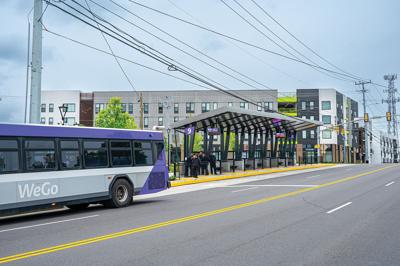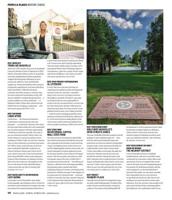Street View is a monthly column taking a close look at development-related issues affecting different neighborhoods throughout the city.
In many ways, Urban Housing Solutions’ property 26th & Clarksville looks like smart city planning. The 141-unit property offers affordable housing for seniors, disabled people, and low- and middle-income Nashvillians. And significantly, it’s next to the Ernest “Rip” Patton North Nashville Transit Center, so residents can easily get to other parts of the city.
WeGo says the transit center — set to open this spring — is currently ‘80 percent finished’
While 26th & Clarksville works well for its residents, it’s far too unusual in a city that’s missing affordable housing within easy distance of transit. But it could provide a key for how to build Nashville’s future.
Mayor Freddie O’Connell’s “Choose How You Move” transit initiative — successfully passed by referendum in November — has identified 10 “all-access corridors,” heavily used streets with significant planned upgrades including more frequent transit service, more sidewalks and improved signals. At the same time, the mayor’s office has identified affordable housing as a crucial city need. O’Connell discussed housing needs in this month’s annual State of Metro address and echoed these concerns in a recent interview with the Scene, in which he mentioned transport-accessible housing and advocated for responsible, careful housing policy changes at the Metro Council district level.
Housing and transit also came together in a recent study from The Urban Institute, which suggests that building affordable housing close to O’Connell’s proposed all-access corridors would help many residents while boosting WeGo ridership — keeping the bus system running well. Currently, the study estimates that only 13 percent of Nashville housing is within a quarter-mile of these corridors.
Offering vision but few details, mayor shifts focus to housing as reports pile up about supply shortfall
Overall, the Metro Planning Department’s recent Unified Housing Strategy suggests that the city should anticipate the need for an additional 90,000 units over the next 10 years to meet the demand forecast by Planning’s Housing Division.
But how would the city build more units near transit?
The Urban Institute study offers one solution: zoning changes. Inflexibilities in Nashville’s zoning code are preventing accessible neighborhoods from being affordable, the researchers find. “If the neighborhoods with the best transit access are also those experiencing gentrification, people with low incomes may be unable to take advantage of the affordable, reliable and frequent means of transportation these options allow,” the authors write. This could also lead to lack of fare revenues, the study finds: “Locating housing near transit options is a key mechanism to secure the financial stability of Nashville’s transit system.”
The Urban Institute report has three options for how more transit-oriented housing could happen: “legalize,” allowing multifamily housing on any lot zoned for commercial or business use within a quarter-mile of all-access transit corridors; “plexify,” creating zoning to allow up to four units on single- or double-family-zoned lots; and “intensify,” allowing up to 60 units per acre on any residential zone within a quarter-mile of all-access transit corridors.
Overall, the Urban Institute study found that the “plexify” reform would create the most new housing, opening the potential for nearly 300,000 units. The “legalize” and “intensify” reforms could also create the potential for additional units, though these units may be less likely in areas that are zoned for commercial use.
City leaders have offered other solutions as well, including continued investment in tools like rental support and shared equity housing. In his State of Metro address, O’Connell mentioned a $16 million investment in the Barnes Housing Trust Fund. He also touched on the need for rezoning to allow more affordable housing to be built.
But while studies suggest zoning changes can facilitate both affordable housing and better access to transit, those can also come with additional infrastructure needs. And perhaps most significantly, even when zoning makes sense on paper, it’s unclear whether Nashville neighborhoods will allow it to happen.
“I think people recognize the problem [of housing shortages] and overall support public change to address the problem,” says Brent Elrod, Urban Housing Solutions’ managing director. “But when it really gets real and it’s in someone’s neighborhood, it doesn’t seem like it plays out with the same level of popularity.
“There’s a gap between ideas and actions,” he continues.
Oftentimes, neighborhood associations can lobby to preserve “neighborhood character” and oppose new development. But that’s not the case everywhere: Some neighborhoods have worked together to plan new development that residents support, like a walkable East End neighborhood’s push to add “gentle density” through rezoned multifamily housing and revised Historic Zoning guidelines. Accessibility was important to this group too: Residents believed the neighborhood was a good candidate for rezoning because it already had walkable infrastructure in place.
Elrod, too, has seen enthusiasm for affordable housing in some communities. “We’ve seen real support for having affordable housing opportunities in Wedgewood-Houston and especially in the Chestnut Hill neighborhood,” he says.
Also: Housing proposals targeting South and East Nashville neighborhoods advance
While high-density, well-connected properties like Urban Housing Solutions’ 26th & Clarksville work well, they’re not the only answer. Just last week, the Metro Council moved forward with plans to redevelop longtime Goodlettsville shopping center RiverGate Mall, with developer Merus saying it will reserve land for a multimodal transit facility and make affordable senior housing units available.
“Our solutions for affordable housing are as varied as our demographics as a community,” says Elrod. When asked about his ideal scenario, he says he’d like to build more housing close to a transit center, somewhere “really well-connected.” And he’d want the housing to be in a community that has what people need: “ample job opportunities, services, parks and community infrastructure.”
“You know,” Elrod says. “What everybody wants and really deserves access to.”








